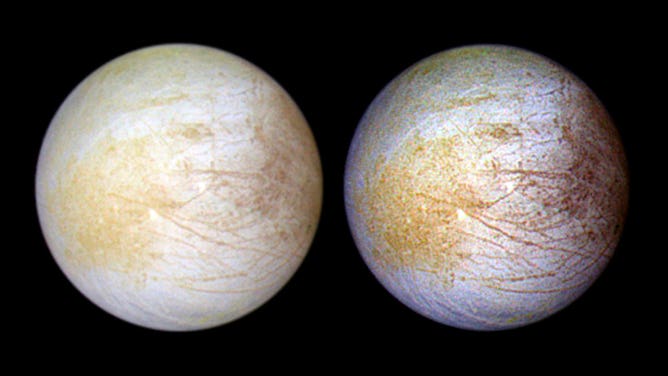SpaceX launches NASA mission to Jupiter's ocean-world moon Europa
NASA's Europa Clipper spacecraft weighs nearly 13,000 pounds, about the same weight as an African elephant. SpaceX launched the mission on its Falcon Heavy rocket from Florida, beginning a 1.8 billion mile journey for the spacecraft.
NASA's Europa Clipper mission to study Jupiter's moon with global ocean
NASA's Europa Clipper spacecraft will travel 1.8 billion miles to study Jupiter's moon Europa believed to have a global ocean with essential elements for life. (Video: NASA)
KENNEDY SPACE CENTER, Fla. – After Hurricane Milton delayed NASA's mission to Jupiter's moon Europa, SpaceX had a better forecast on Monday and successfully launched the Europa Clipper spacecraft from Florida.
SpaceX launched its Falcon Heavy rocket with NASA's Europa Clipper spacecraft from Kennedy Space Center (KSC) launchpad 39A at 12:06 p.m. ET.
The spacecraft was initially slated to launch on Oct. 10, but Hurricane Milton made landfall on Florida's Gulf Coast the day prior, causing widespread destruction across the Sunshine State, including on Florida's Space Coast.
JUPITER'S MOON EUROPA PRODUCES ENOUGH OXYGEN TO KEEP A MILLION HUMANS BREATHING FOR A DAY
Kennedy Space Center's Damage Assessment and Recovery Team completed a review of the center and its facilities to determine whether it was safe to resume work and proceed with the launch of Europa Clipper.
NASA required SpaceX's Falcon Heavy rocket with three boosters to send the Europa Clipper spacecraft on its journey. The spacecraft is the largest NASA has ever developed for a planetary mission and weighs nearly 13,000 pounds with fuel, about the same weight as an African elephant.
About one hour after liftoff, the spacecraft separated from the Falcon's second stage to begin its 1.8-billion-mile trek to the Jovian system. Mission control at NASA's Jet Propulsion Laboratory in California reported receiving telemetry and a signal from the spacecraft.
Once on its own in space, Europa Clipper's solar arrays will open, making the spacecraft about as long as a basketball court.
JAMES WEBB SPACE TELESCOPE CAPTURES JUPITER'S SWIRLING WEATHER, COLORFUL AURORAS AND RINGS
Europa Clipper will spend nearly five years reaching its destination and complete the first detailed study of the moon Europa with a suite of nine instruments, including cameras and ice-penetrating radar. Scientists believe a global ocean lies beneath Europa's icy crust, which may contain twice as much liquid as Earth's oceans and the ingredients for life.

This photograph of the Jovian moon Europa was taken in June 1997 at a range of 776,700 miles by NASA's Galileo spacecraft.
(NASA)
Throughout its mission, the spacecraft will complete nearly 50 flybys of Europa, investigating the salty ocean beneath its surface to understand its geology and how the ocean below interacts with the icy crust above.
Europa Clipper is expected to arrive in Jupiter's orbit by April 2030.
